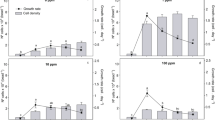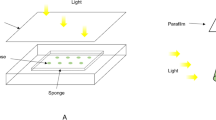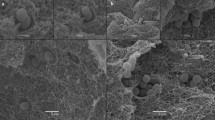Abstract
This study examined the co-immobilization of the cyanobacterium Synechococcus elongatus with the plant growth-promoting bacterium Azospirillum brasilense in alginate beads and its potential application for the removal of phosphorus from aquaculture wastewater. Co-immobilization of both microorganisms significantly increased the cell density of S. elongatus (2852.5 × 104 cells mL−1) compared with that of immobilization of cyanobacteria alone (1325.2 × 104 cells mL−1). Chlorophyll a content was similar in co-immobilized (11.1 ± 3.5 pg cell−1) and immobilized S. elongatus (14.5 ± 4.9 pg cell−1). Azospirillum brasilense showed continuous growth until day 2, after which its cell concentration declined until the end of the assay. Co-immobilized S. elongatus removed more phosphorus (44.8 %) than immobilized cyanobacteria cells alone (32.0 %). In conclusion, phosphate removal was greater with free cells of S. elongatus but overlapped with the values that were obtained with the treatment of co-immobilization of cells. Our results demonstrate that A. brasilense enhances the growth of S. elongatus and improves its removal of phosphorus when they are co-immobilized in alginate beads compared with only immobilization of cyanobacteria cells alone.



Similar content being viewed by others
References
Aguilar-May B, Sánchez-Saavedra MP (2009) Growth and removal of nitrogen and phosphorus by free-living and chitosan-immobilized cells of the marine cyanobacterium Synechococcus elongatus. J Appl Phycol 21:353–360
APHA, AWWA, WPCF (American PublicHealth Association, American Water Works Association, Water Pollution Control Federation) (1992) Standard methods for the examination of water and wastewater. Washington DC, p 1105.
Asai T, Iizuka H, Komagata K (1964) The flagellation and taxonomy of genera gluconobacter and acetobacter with reference to the existence of intermediate strains. J Gen Appl Microbiol 10:95–126
Bashan Y (1986) Alginate beads as synthetic inoculant carriers for the slow release of bacteria that affect plant growth. Appl Environ Microbiol 51:1089–1098
Bashan Y, Holguin G, Lifshitz R (1993) Isolation and characterization of plant growth-promoting rhizobacteria. In: Glick BR, Thompson JE (eds) Methods in plant molecular biology and biotechnology. CRC Press, Boca Raton, pp 331–345
Billini M, Stamatakis K, Sophianopoulou V (2008) Two members of a network of putative Na/H antiporters are involved in salt and pH tolerance of the freshwater cyanobacterium Synechococcus elongatus. J Bact 190:6318–6329
Brummell DA, Hall JL (1987) Rapid cellular responses to auxins and the regulation of growth. Plant Cell Environ 10:523–543
Castro-Ceseña AB, Sánchez-Saavedra MP (2015) Effect of glycerol and PEGMA coating on the efficiency of cell holding in alginate immobilized Synechococcus elongatus. J Appl Phycol doi: 10.1007/s10811-015-0552-2.
Chevalier P, de la Noüe J (1985) Wastewater nutrient removal with microalgae immobilized in carrageenan. Enzyme Microb Technol 7:621–624
Covarrubias SA, de-Bashan LE, Moreno M, Bashan Y (2012) Alginate beads provide a beneficial physical barrier against native microorganisms in wastewater treated with immobilized bacteria and microalgae. Appl Microbiol Biotechnol 93:2669–2680
Cruz I, Bashan Y, Hernández-Carmona G, de-Bashan LE (2013) Biological deterioration of alginate beads containing immobilized microalgae and bacteria during tertiary wastewater treatment. Appl Microbiol Biotechnol 97:9847–9858
de-Bashan LE, Bashan Y (2004) Recent advances in removing phosphorus from wastewater and its future use as fertilizer (1997–2003). Water Res 38:4222–4246
de-Bashan LE, Bashan Y (2008) Bacterias promotoras de crecimiento en plantas y microalgas verdes: un modelo conveniente para el estudio básico de las interacciones planta-bacteria. In: Cassán FD, Gracia de Salomone I (eds) Azospirillum sp.: cell physiology, plant interactions and agronomic research in Argentina. Asociación Argentina de Microbiología, Buenos Aires, pp 37–48
de-Bashan LE, Bashan Y (2010) Immobilized microalgae for removing pollutants: review of practical aspects. Bioresour Technol 6:1611–1627
de-Bashan LE, Hernández JP, Morey T, Bashan Y (2004) Microalgae growth promoting bacteria as “helpers” for microalgae: a novel approach for removing ammonium and phosphorus from municipal wastewater. Water Res 38:466–474
de-Bashan LE, Antoun H, Bashan Y (2008) Involvement of indole-3-aceticacid produced by the growth-promoting bacterium Azospirillum spp. in promoting growth of Chlorella vulgaris. J Phycol 44:938–947
Donnert D, Salecker M (1999) Elimination of phosphorus from waste water by crystallization. Environ Technol 20:735–742
Dumas A, Laliberte G, Lessard P, de la Noue J (1998) Biotreatment of fish farm effluents using the cyanobacterium Phormidium bohneri. Aquacult Eng 17:57–68
Fierro S, Sánchez-Saavedra MP, Copalcúa C (2008) Nitrate and phosphate removal by chitosan immobilized Scendesmus. Bioresour Technol 99:1274–1279
Fogg GE, Thake BJ (1987) Algal cultures and phytoplankton ecology. University of Wisconsin Press, London, p 448
Fogg GE, Stewart WDP, Fay P, Walsby E (1973) The blue-green algae. Academic Press, London, p 437
González LE, Bashan Y (2000) Increased growth of the microalga Chlorella vulgaris when co-immobilized and cocultured in alginate beads with the plant-growth-promoting bacterium Azospirillum brasilense. Appl Environ Microbiol 4:1527–1531
Guillard RLL, Ryther JH (1962) Studies on marine planktonic diatoms: I. Cyclotella nana Hustedt and Detonula confervacea (Cleve) Gran. Can J Microbiol 8:229–239
Hernandez JP, de-Bashan LE, Bashan Y (2006) Starvation enhances phosphorus removal from wastewater by the microalgae Chlorella spp. co-immobilized with Azospirillum brasilense. Enzyme Microb Technol 38:190–198
Hernández JP, de-Bashan LE, Rodriguez DJ, Rodriguez Y, Bashan Y (2009) Growth promotion of the freshwater microalga Chlorella vulgaris by the nitrogen-fixing, plant growth-promoting bacterium Bacillus pumilus from arid zone soils. Eur J Soil Biol 45:88–93
Kaya VM, Picard G (1995) The viability of Scenedesmus bicellularis cells immobilized on alginate screens following nutrient starvation in air at 100% relative humidity. Biotechnol Bioeng 46:459–464
Kolot FB (1988) Principles, techniques and industrial applications. Immobilized microbial systems. Krieger, New York, p 206
Lananan F, Abdul Hamid SH, Din WNS, Na A, Khatoon H, Jusoh A, Endut A (2014) Symbiotic bioremediation of aquaculture wastewater in reducing ammonia and phosphorus utilizing effective microorganism (EM-1) and microalgae (Chlorella sp.). Int Biodeterior Biodegrad 95:127–134
Lau PS, Tam NFY, Wong YS (1998) Effect of carrageenan immobilization on the physiological activities of Chlorella vulgaris. Bioresour Technol 63:115–121
Lin YF, Jing SR, Lee DY, Wang TW (2002) Nutrient removal from aquaculture wastewater using a constructed wetlands system. Aquaculture 209:169–184
Mallick N (2002) Biotechnological potential of immobilized algae for wastewater N, P and metal removal: a review. Biometals 15:377–390
Mallick N, Rai LC (1993) Influence of culture density, pH, organic acids and divalent cations on the removal of nutrients and metals by immobilized Anabaena doliolum and Chlorella vulgaris. World J Microbiol Biotechnol 9:196–201
Mook WT, Chakrabarti MH, Aroua MK, Khan GMA, Ali BS, Islam MS, Abu Hassan MA (2012) Removal of total ammonia nitrogen (TAN), nitrate and total organic carbon (TOC) from aquaculture wastewater using electrochemical technology: a review. Desalination 285:1–13
Moreno-Garrido I (2008) Microalgae immobilization: current techniques and uses. Bioresour Technol 99:3949–3964
Nora’aini AA, Wahab M, Ahmad J (2005) Treatment of aquaculture wastewater using ultra-low pressure asymmetric polyethersulfone (PES) membrane. Desalination 185:317–326
Ohto C, Ishida C, Nakane H, Muramatsu M, Nishino T, Obata S (1999) A thermophilic cyanobacterium Synechococcus elongatus has three different class I prenyltransferase genes. Plant Mol Biol 40:307–321
Pane L, Feletti M, Bertino C, Carli A (1998) Viability of the marine microalga Tetraselmis suecica grown free and immobilized in alginate beads. Aquacult Int 6:411–420
Parsons TR, Maita Y, Lalli CM (1984) A manual of chemical and biological methods for seawater analysis. Pergamon Press, Oxford, p 173
Pires JCM, Alvim-Ferraz MCM, Martins FG, Simoes M (2013) Wastewater treatment to enhance the economic viability of microalgae culture. Environ Sci Pollut Res 20:5096–5105
Rosales N, Ortega J, Mora R, Morales E (2005) Influencia de la salinidad sobre crecimiento y composición bioquímica de la cianobacteria Synechococcus sp. modulados. Cienc Mar 31:349–355
Smidsrød O, Skjåk-Bræk G (1990) Alginate as immobilization matrix for cells. Trends Biotechnol 8:71–78
Smith VH (2003) Eutrophication of freshwater and coastal marine ecosystems. Environ Sci Pollut Res 10:126–139
StatSoft, Inc. (2004) Statistica for Windows.Tulsa, OK, USA.
Tam NFY, Wong YS (2000) Effect of immobilized microalgal bead concentrations on wastewater nutrient removal. Environ Pollut 107:145–151
Tortora G, Funke B, Case C (2007) Introducción a la microbiología. Médica Panamericana, Buenos Aires, p 931
Verduin J (1964) Principles of primary productivity: photosynthesis under completely natural conditions. In: Jackson DF (ed) Algae and man. Plenum Press, New York, pp 221–238
Waterbury JB, Watson SW, Valois FW, Franks DG (1986) Biological and ecological characterization of the marine unicellular cyanobacterium Synechococcus. Can Bull Fish Aquat Sci 214:71–120
Zamani N, Noshadi M, Amin S, Niazi A, Ghasemi Y (2012) Effect of alginate structure and microalgae immobilization method on orthophosphate removal from wastewater. J Appl Phycol 24:649–656
Acknowledgments
This study was supported by Consejo Nacional de Ciencia y Tecnología de México (CONACyT Project 130074). The first author acknowledges a CONACyT special scholarship. Thanks to Ceres Molina-Cárdenas for the technical assistance and thanks to Blue Pencil Science for English editing.
Author information
Authors and Affiliations
Corresponding author
Rights and permissions
About this article
Cite this article
Ruiz-Güereca, D.A., Sánchez-Saavedra, M.d.P. Growth and phosphorus removal by Synechococcus elongatus co-immobilized in alginate beads with Azospirillum brasilense . J Appl Phycol 28, 1501–1507 (2016). https://doi.org/10.1007/s10811-015-0728-9
Received:
Revised:
Accepted:
Published:
Issue Date:
DOI: https://doi.org/10.1007/s10811-015-0728-9




